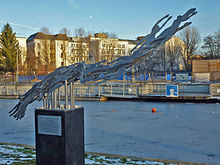Elstermühlgraben (Leipzig)

The Elstermühlgraben is an approximately 4000 meter long, now partially underground mill canal in the city of Leipzig , which has existed as an artificial branch of the White Elster for about 1000 years.
geography
In its current course, which has been corrected several times, the Elstermühlgraben is created as a right branch of the Elster flood bed , shortly before it receives the White Elster coming from the left and flows into the Elster basin at the Palmengarten weir . It first moves in a north-easterly direction towards the city center, about half of the route is underground, then forms a knee at the level of the Ranstädter Steinweg (which it crosses under) and continues to flow in a north-westerly direction between Waldstraßenviertel and Rosental back towards the White Elster, to eventually flow into them again. The northern part of the Mühlgraben follows the bed of the old Elster.
The Peterssteg at the beginning of the trench, the Holy Bridge on Moschelesstrasse and the Schreberbrücke on Schreberstrasse lead across the Elstermühlgraben . In the vicinity of the new weir at the planned city harbor, the Blüthnersteg was built and named in memory of Julius Blüthner's piano factory, which was once next to it . At the west bridge , the Elstermühlgraben crosses under Friedrich-Ebert-Straße and then, in its currently still piped course, Elsterstraße at the Elsterbrücke and Lessingstraße at the Poniatowskibrücke . Behind Lessingstrasse, the Mühlgraben runs above ground again and passes under the Funkenburgbrücke , Fischersteg, Carusbrücke, Lautensteg and the Angermühlbrücke on Ranstädter Steinweg, then the Gustav-Adolf-Brücke and Leibnizbrücke on the streets of the same name. At Liviaplatz, the Fregesteg leads from the Waldstraßenviertel into the Rosental, followed by the Waldstraßenbrücke, the Leutzscher Allee bridge and, finally, before the confluence with the Elster, the Staxbrücke at the Rosental sewage works .
history
In the 12th century the Elstermühlgraben was created to regulate the regular spring floods and to operate mills. Some of these were still preserved and in use until the late 19th century (such as the Angermühle, which was demolished in 1878). A settlement on the bank of the Mühlgraben has been documented since the early 13th century. Until the strong expansion of Leipzig around 1850, the canal was completely outside of the actual city. In the course of the expansion of the Ranstädter Steinweg, the Mühlgraben was arched in this area in 1878. In the 20th century, the Leipzig rivers were very heavily polluted by sewage discharge and their inner-city courses were largely vaulted or piped, as was the Elstermühlgraben around 1960. After the reunification, the water quality improved noticeably, which is why the formerly almost 1000 meter long underground section of the Mühlgraben has been exposed again in stages for renaturation and to improve the quality of living and leisure time and flood protection.
The first construction phase of the opening of the Elstermühlgraben from Thomasiusstraße to the Angermühlbrücke was completed in September 2007, the second construction phase between the Schreberbrücke and Friedrich-Ebert-Straße in August 2010. Since September 2013 work has been carried out on the third construction phase. On May 21, 2015, the first partial construction section (3.3) along Carl-Maria-von-Weber-Straße was inaugurated. After temporary delays in the construction process, the section between Thomasiusstrasse and Lessingstrasse has now been exposed again. The last section from Elsterstrasse to Lessingstrasse remains, the disclosure of which should be completed by 2023.
Since 2003 it has been planned to reopen the old Elster from the Elstermühlgraben from Schreberbad to the north of the Waldstraßenviertel in a slightly different course as the main bed of the Elster.
At Elstermühlgraben, next to the Schreberbad, the Leipzig city harbor for tourist and pleasure boats was inaugurated in April 2014. The metal sculpture by Rainer Henze "The Wave - 100 Years of the DLRG" at the city harbor is a reminder of the DLRG's foundation in Leipzig in 1913.
Web links
- Rivers + Lakes: Flowing waters of the 2nd order on the website of the City of Leipzig
- Renaturation projects: Elstermühlgraben on the website of the City of Leipzig
Individual evidence
- ^ Horst Riedel: Stadtlexikon Leipzig from A to Z. Pro Leipzig, Leipzig 2005, ISBN 3-936508-03-8 , front cover
- ↑ Book-City-Plan Leipzig and the surrounding area. (M 1: 20,000), Verlag Dr. Barthel, Borsdorf 2007, ISBN 978-3-89591-011-1
- ↑ Leipzig Council Assembly: Resolution No. RBIV-1550/09 (PDF; 28 kB) of March 18, 2009 on the renaming of bridges over the Elstermühlgraben.
- ^ Office for Statistics and Elections: Renaming of bridges. Leipzig Official Journal No. 7/2009 of March 28, 2009, p. 10
- ↑ Leipzig Lexicon: Bridges
- ↑ Elstermuehlgraben on: leipzig-lexikon.de
- ↑ Elstermühlgraben: Groundbreaking ceremony for third construction phase . Website of the City of Leipzig, published on September 4, 2013, accessed on March 2, 2015.
- ↑ Elstermühlgraben: Exposed section between Friedrich-Ebert-Straße and Elsterstraße opened . Website of the City of Leipzig, published on May 21, 2015, accessed on July 1, 2015.
- ↑ The Elstermühlgraben is taking longer to open than planned . Website of the City of Leipzig, published on May 4, 2018, accessed on April 24, 2019.
- ↑ Another section of the Elstermühlgraben opened . Website of the City of Leipzig, published on June 11, 2019, accessed on August 19, 2019.
- ^ André Loh-Kliesch: White Elster . on leipzig-lexikon.de



